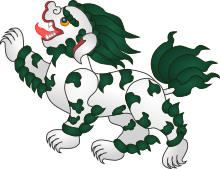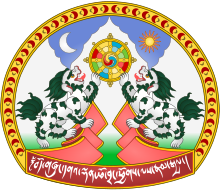Snow Lion

TheSnow Lion(sometimes spelledsnowlion;Tibetan:གངས་སེང་གེ་,Wylie:gangs seng ge;Chinese:Tuyết sư) is acelestialanimal ofTibet.It is the emblem of Tibet, representing the snowy mountain ranges and glaciers of Tibet,[1]and may also symbolize power and strength, and fearlessness and joy, east and the earth element.[2][3]It is one of theFour Dignities.[4]It ranges over the mountains, and is commonly pictured as being white with aturquoisemane. InJourney to the Westpublished in 1592, Snow Lion is depicted as one ofmonster-spirits.[5]
As national emblem of Tibet[edit]


From 1909 until 1959, a single snow lion or a pair of them was used as the nationalemblem of Tibeton coins, postage stamps, banknotes and the national flag of Tibet. The version shown on right with two Snow Lions was introduced by the13th Dalai Lamain 1912 based on old military banners, and is still used by theGovernment of Tibet in Exile.[1]The flag is popularly known as theSnow Lion Flag(gangs seng dar cha).[6]

In Tibetan culture[edit]

Snow lion is frequently mentioned in Tibetan folk songs and proverbs. It is thought to live in the highest mountains as it is the "king of beasts" that would tower over other animals of the lower levels. Snow lions may also represent hermits andyogiswho live high up in the mountains.[1]Marpawas called to interpret the meaning when, "Tibet's great yogin,Milarepa,once had a prophetic dream which included a snow lion. "[7]
Snow Lioness milk[edit]
In Tibetan lore, two Tibetanculture heroes,GesarandMilarepa,were said to have been raised by snow lioness.[1]The milk of the Snow Lioness (Tibetan: Gangs Sengemo) is reputed to contain special nutrients to heal the body and restore it to harmony. Some holy medicinal remedies are believed to contain the essence of Snow Lioness milk. Her milk is also used to symbolise theDharmaand its purity, as Milarepa replies to a man seeking to buy the Dharma from him with expensive gifts:
"I, the snow lioness who stays in snowy solitudes, Have milk which is like the essential nectar. In the absence of golden cups, I would not pour it in an ordinary vessel."
Legend has it that the lioness produces milk from its paws, and the milk may pass into hollow balls given to the lioness to play with. This ball may be represented in Tibetan art as a three-coloured "wheel of joy" (dga' 'khyil).[8]
Snow Lion dance[edit]

A form oflion dancefound in the Tibetan areas is called the snow lion dance orSenggeh Garcham.[9]The nameseng geand its related forms come fromSanskritsiṅha,[1]andchamorgarchamis a Buddhist ritual dance.[10]The snow lion dance may be performed as a secular dance, or as a ritual dance performed bybon pomonks.[1]This dance may also be found among people in otherHimalayanregions such as theMonpa peopleinArunachal Pradesh,[11]and inSikkimwhere it is calledSinghi Chham.[12]
In Buddhist art[edit]

The lion was adopted as a symbol ofShakyamuni Buddhain early Buddhism; it is also depicted as a vehicle for a number ofVajrayanadeities such asVaishravanaandManjushri,and the lion throne may be found in manynirmanakayaBuddha forms. The lion in India art is represented in Tibetan Buddhist art as the Snow Lion.[8]The Snow Lion is the protector of Buddha and in paintings and sculpture is usually seen as holding up the Buddha's throne (one on the left and one on the right of the throne.) The throne of a Buddha may also be depicted with eight Snow Lions representing the 8 mainBodhisattvasof Buddha Shakyamuni.[4]
The body of the Snow Lion is white while its flowing hair of mane, tail and curls on legs, is either blue or green. While most Snow Lions are gender neutral in Buddhist art there are some that are represented as obviously male and some as obviously female. When represented as a symmetrical pair the male is on the left and the female on the right. Sculptural Snow Lions are often in repousse metal that has been gilt and painted.
Attributes[edit]


The Snow Lion is atulkuor personification of the primordial playfulness ofananda"joy, bliss" (Wylie:dga'), comparable to the westernunicorn.Though paradoxical, the Snow Lion does not fly but their feet never touch the ground; their existence is a playful continuum (Wylie:rgyud) of leaping from mountain peak to mountain peak. The energetic potency (wisdom orshakti) of the Snow Lion is expressed in the attribute of thegankyilor "ananda-wheel" the Snow Lion keep in eternal play. The gankyil is the principalpolyvalentsymbol and teaching tool of all the doctrinal trinities ofDzogchenand is the energetic signature of thetrikaya.The gankyil is the inner wheel of theDharmacakraof theAshtamangalapath ofVajrayanaBuddhism.
Roar[edit]
The roar of the Snow Lion embodies the sound of 'emptiness' (Sanskrit:Śūnyatā), courage and truth, and because of this is often a synonym for theBuddhadharma,the Buddha’s teachings, as it implies freedom fromkarmaand the challenging call toawakening.It was considered to be so powerful that just a single roar could cause sevendragonsto fall from the sky.
Tibetan Lion Dog[edit]
TheShih Tzu,[13]Lhasa ApsoandTibetan Terrierare also called the Lion Dog which may be due to their resemblance to the Snow Lion.[7]However it is unknown whether the dogs were bred to resemble the Snow Lion or if the artistic depiction of the Snow Lion was influenced by the features of the dogs.
See also[edit]
References[edit]
- ^abcdefSchrempf, Mona (2002), Huber, Toni (ed.),Amdo Tibetans in Transition: Society and Culture in the Post-Mao Era(PDF),Brill, pp. 147–169,ISBN9004125965
- ^"Legend of the SnowLion".Snow Lion Tour.
- ^"Tibetan Buddhist Symbols".A view on Buddhism.
- ^abRudy Harderwijk."The Four Dignities".Symbols of Tibetan Buddhism.A View on Buddhism. Archived fromthe originalon October 13, 2004.Retrieved19 January2007.
- ^Ngô thừa ân (25 October 2014).Tây Du Ký: Journey to the West.Google Publishing. pp. 524–. GGKEY:641CHU5H2P8.
- ^Lama Jabb (10 June 2015).Oral and Literary Continuities in Modern Tibetan Literature: The Inescapable Nation.Le xing ton Books. p. 35.ISBN9781498503341.
- ^abBeer, Robert(1999).The encyclopedia of Tibetan symbols and motifs.Serindia. p. 80.ISBN9780906026489.
- ^abBeer, Robert(10 September 2003).The encyclopedia of Tibetan Buddhist symbols and motifs.Serindia. pp. 63–64.ISBN978-1932476033.
- ^"Tibetan Snow Lion Dance".Tibet Views.Archived from the original on 4 March 2016.
{{cite web}}:CS1 maint: unfit URL (link) - ^"Garcham".itibetan.org.
- ^"Tawang Festival".India Travel.Archived fromthe originalon 25 January 2013.
- ^Gupta, Shobhna (2007).Dances of India.Har-Anand. p. 76.ISBN978-8124108666.
- ^Joris, Victor (1994).The Complete Shih Tzu.Howell Book House. p. 10.ISBN9780876053362.
